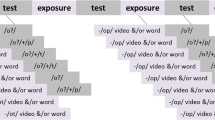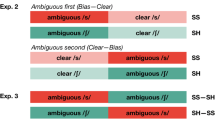Abstract
This study investigates two variables that may modify lexically guided perceptual learning: individual hearing sensitivity and attentional abilities. Older Dutch listeners (aged 60+ years, varying from good hearing to mild-to-moderate high-frequency hearing loss) were tested on a lexically guided perceptual learning task using the contrast [f]-[s]. This contrast mainly differentiates between the two consonants in the higher frequencies, and thus is supposedly challenging for listeners with hearing loss. The analyses showed that older listeners generally engage in lexically guided perceptual learning. Hearing loss and selective attention did not modify perceptual learning in our participant sample, while attention-switching control did: listeners with poorer attention-switching control showed a stronger perceptual learning effect. We postulate that listeners with better attention-switching control may, in general, rely more strongly on bottom-up acoustic information compared to listeners with poorer attention-switching control, making them in turn less susceptible to lexically guided perceptual learning. Our results, moreover, clearly show that lexically guided perceptual learning is not lost when acoustic processing is less accurate.




Similar content being viewed by others
Notes
In The Netherlands, people are entitled to a partial refund of the costs of a hearing aid from their health insurance if this average threshold exceeds 35 dB HL in their poorer ear. So, hearing loss of the participants, if present, was mostly mild to moderate.
We reran the analysis excluding all (three, outlier) poorer-hearing participants with a PTABest of over 35 dB HL to investigate whether there is an effect of selective attention for the people with better hearing which might have been obscured by the results of the listeners with poor hearing. The results were the same as the results reported here, i.e., only an effect of attention-switching control was found, while still no effect was found for selective attention.
References
Adank, P., & Janse, E. (2010). Comprehension of a novel accent by young and older listeners. Psychology and Aging, 25(3), 736–740.
Baayen, R. H., Davidson, D. J., & Bates, D. M. (2008). Mixed-effects modeling with crossed random effects for subjects and items. Journal of Memory and Language, 59, 390–412.
Barr, D. J., Levy, R., Scheepers, C., & Tily, H. J. (2013). Random effects structure for confirmatory hypothesis testing: Keep it maximal. Journal of Memory and Language, 68, 255–278.
Boersma, P., & Weenink, D. (2005). Praat. Doing phonetics by computer (Version 5.1).
Chatterjee, S., Hadi, A. S., & Price, B. (2000). Regression analysis by example. New York: John Wiley & Sons.
Cunnings, I. (2012). An overview of mixed-effects statistical models for second language researchers. Second Language Research, 28(3), 369–382.
Cutler, A. (2012). Native listening: The flexibility dimension. Dutch Journal of Applied Linguistics, 1(2), 169–187.
Cutler, A., McQueen, J. M., Butterfield, S., & Norris, D. (2008). Prelexically-driven perceptual retuning of phoneme boundaries. Proceedings of Interspeech, 2056–2056.
Davis, M. H., Johnsrude, I. S., Hervais-Adelman, A., Taylor, K., McGettigan, C. (2005). Lexical information drives perceptual learning of distorted speech: evidence from the comprehension of noise-vocoded sentences. Journal of Experimental Psychology: General, 134(2), 222–241.
Eisner, F., & McQueen, J. M. (2005). Perceptual learning in speech: Stability over time. Journal of the Acoustical Society of America, 119, 1950–1953.
Eriksen, B. A., & Eriksen, C. W. (1974). Effect of noise letters on upon the target identification in a non-search task. Perception and Psychophysics, 16, 143–149.
Goldstone, R. L. (1998). Perceptual learning. Annual Review of Psychology, 49, 585–612.
Golomb, J. D., Peelle, J. E., & Wingfield, A. (2007). Effects of stimulus variability and adult aging on adaptation to time-compressed speech. Journal of the Acoustical Society of America, 121, 1701–1708.
Gordon-Salant, S., Yeni-Komshian, G. H., & Fitzgibbons, P. J. (2010a). Recognition of accented English in quiet by younger normal-hearing listeners and older listeners with normal-hearing and hearing loss. Journal of the Acoustical Society of America, 128(1), 444–455.
Gordon-Salant, S., Yeni-Komshian, G. H., & Fitzgibbons, P. J. (2010b). Recognition of accented English in quiet and noise by younger and older listeners. Journal of the Acoustical Society of America, 128(5), 3152–3160.
Hervais-Adelman, A., Davis, M. H., Johnsrude, I. S., Carlyon, R. P. (2008). Perceptual learning of noise vocoded words: effects of feedback and lexicality. Journal of Experimental Psychology: Human Perception & Performance, 34(2), 460–474. doi:10.1037/0096-1523.34.2.460.
Janse, E., & Adank, P. (2012). Predicting foreign-accent adaptation in older adults. Quarterly Journal of Experimental Psychology, 65(8), 1563–1585. doi:10.1080/17470218.2012.658822
Janse, E., & Newman, R. S. (2013). Identifying non-words: Effects of lexical neighborhoods, phonotactic probability, and listener characteristics. Language and Speech, 56, 421–441.
Jesse, A., & McQueen, J. M. (2011). Positional effects in the lexical retuning of speech perception. Psychonomic Bulletin & Review, 18, 943–950. doi:10.3758/s13423-011-0129-2
Kawahara, H., Masuda-Katsuse, I., & Cheveigne, A. (1999). Restructuring speech representations using a pitch-adaptive time-frequency smoothing and an instantaneous-frequency-based F0 extraction: Possible role of a repetitive structure in sounds. Speech Communication, 27, 187–207.
Maniwa, K., Jongman, A., & Wade, T. W. (2008). Perception of clearfricatives by normal-hearing and simulated hearing-impaired listeners. The Journal of the Acoustical Society of America, 123, 1114–1125. doi:10.1121/1.2821966
Mattys, S., Brooks, J., & Cooke, M. (2009). Recognizing speech under a processing load: Dissociating energetic from informational factors. Cognitive Psychology, 59, 203–243.
Mattys, S. L., & Scharenborg, O. (2014). Phoneme categorization and discrimination in younger and older adults: A comparative analysis of perceptual, lexical, and attentional factors. Psychology and Aging, 29(1), 150–162. doi:10.1037/a0035387
Mattys, S. L., Seymour, F., Attwood, A. S., & Munafò, M. R. (2013). Effects of acute anxiety induction on speech perception: Are anxious listeners distracted listeners? Psychological Science, 24(8), 1606–8. doi:10.1177/0956797612474323
Mattys, S., & Wiget, L. (2011). Effects of cognitive load on speech recognition. Journal of Memory and Language, 65, 145–160.
McCabe, D. P., Roediger, H. L., McDaniel, M. A., Balota, D. A., & Hambrick, D. Z. (2010). The relationship between working memory capacity and executive functioning: Evidence for a common executive attention construct. Neuropsychology, 24, 222–243.
McCoy, S. L., Tun, P. A., Cox, L. C., Colangelo, M., Stewart, R. A., & Wingfield, A. (2005). Hearing loss and perceptual effort: Downstream effects on older adults’ memory for speech. Quarterly Journal of Experimental Psychology, 58A, 22–33.
McQueen, J. M., Cutler, A., & Norris, D. (2006). Phonological abstraction in the mental lexicon. Cognitive Science, 30(6), 1113–1126.
McQueen, J. M., Tyler, M., & Cutler, A. (2012). Lexical retuning of children’s speech perception: Evidence for knowledge about words’ component sounds. Language Learning and Development, 8, 317–339. doi:10.1080/15475441.2011.641887
Mitterer, H., Scharenborg, O., & McQueen, J. M. (2013). Phonological abstraction without phonemes in speech perception. Cognition.
Miyake, A., Friedman, N. P., Emerson, M. J., Witzki, A. H., & Howerter, A. (2000). The unity and diversity of executive functions and their contributions to complex “frontal lobe” tasks: A latent variable analysis. Cognitive Psychology, 41, 49–100.
Norris, D., McQueen, J. M., & Cutler, A. (2003). Perceptual learning in speech. Cognitive Psychology, 47(2), 204–238.
Nosofsky, R. M. (1986). Attention, similarity, and the identification-categorization relationship. Journal of Experimental Psychology: General, 1, 39–57.
Nosofsky, R. M., Gluck, M., Palmeri, T. J., McKinley, S. C., & Glauthier, P. (1994). Comparing models of rule-based classification learning: A replication and extension of Shepard, Hovland, and Jenkins (1961). Memory & Cognition, 22, 352–369.
Peelle, J. E., & Wingfield, A. (2005). Dissociations in perceptual learning revealed by adult age differences in adaptation to time-compressed speech. Journal of Experimental Psychology: Human Perception and Performance, 31(6), 1315–1330.
Pitt, M. A., & Szostak, C. M. (2012). A lexically biased attentional set compensates for variable speech quality caused by pronunciation variation. Language and Cognitive Processes, 27(7/8), 1225–1239.
R development core team (2011). R: A language and environment for statistical computing. Vienna: R Foundation for Statistical Computing.
Reitan, R. M. (1958). Validity of the Trail Making test as an indicator of organic brain damage. Perceptual and Motor Skills, 8, 271–276.
Rietveld, A. C. M., & van Heuven, V. J. (1997). Algemene Fonetiek. Bussum: Dick Coutinho.
Salthouse, T. A. (2011). What cognitive abilities are involved in trail-making performance? Intelligence, 39, 222–232.
Salthouse, T. A., Atkinson, T. M., & Berish, D. E. (2003). Executive functioning as a potential mediator of age-related cognitive decline in normal adults. Journal of Experimental Psychology: General, 132, 566–594.
Samuel, A. G., & Kraljic, T. (2009). Perceptual learning in speech perception. Attention, Perception & Psychophysics, 71, 1207–1218.
Scharenborg, O., & Janse, E. (2013). Comparing lexically-guided perceptual learning in younger and older listeners. Attention, Perception, and Psychophysics.. doi:10.3758/s13414-013-0422-4
Shanks, D. R. (2003). Attention and awareness in “implicit” sequence learning. In L. Jiménez (Ed.), Attention and implicit learning (pp. 11–42). Amsterdam: Benjamins.
Sher, A. E., & Owens, E. (1974). Consonant confusions associated with hearing loss above 2000 Hz. Journal of Speech and Hearing Research, 17, 669–681.
Unsworth, N., & Engle, R. W. (2005). Individual differences in working memory capacity and learning: Evidence from the serial reaction time task. Memory & Cognition, 33(2), 213–220.
Verhaeghen, P., & De Meersman, L. (1998). Aging and the Stroop effect: A meta-analysis. Psychology and Aging, 13, 120–126.
Zeng, F. G., & Turner, C. W. (1990). Recognition of voiceless fricatives by normal and hearing-impaired subjects. Journal of Speech and Hearing Research, 33, 440–449.
Author Note
This research was carried out while O.S. and A.W. were at the Max Planck Institute for Psycholinguistics, Nijmegen, The Netherlands. The research by O.S. was sponsored by the Max Planck International Research Network on Aging. O.S. is now supported by a Vidi-grant from the Netherlands Organisation for Scientific Research (NWO). The research by E.J. is supported by a (separate) Vidi-grant from NWO. The research by A.W. was funded by the Max Planck Society, Munich, Germany. A.W. is now at the Eberhard Karls University of Tübingen. We thank the student-assistants of the Adaptive Listening Group of the Max Planck Institute for Psycholinguistics and Willemijn van den Berg for assistance in preparing and running these experiments, and Marijt Witteman for recording the stimuli.
Author information
Authors and Affiliations
Corresponding author
Appendixes
Appendixes
Appendix 1
Appendix 2
Results for the hearing and cognitive measures for the two exposure groups given separately. Figure 4 shows mean hearing sensitivity in terms of hearing thresholds from 250 to 8000 kHz of the listeners exposed to the ambiguous sound in/f/-final words (ambF, solid lines) and for the listeners exposed to the ambiguous sound in/s/-final words (ambS, dashed lines). The left ear is plotted in black, the right ear is plotted in grey. Descriptive results for the hearing and cognitive measures for the two exposure groups presented separately are provided in Table 4.
Rights and permissions
About this article
Cite this article
Scharenborg, O., Weber, A. & Janse, E. The role of attentional abilities in lexically guided perceptual learning by older listeners. Atten Percept Psychophys 77, 493–507 (2015). https://doi.org/10.3758/s13414-014-0792-2
Published:
Issue Date:
DOI: https://doi.org/10.3758/s13414-014-0792-2




